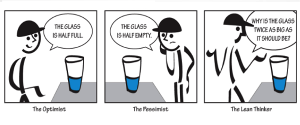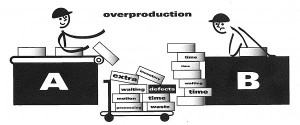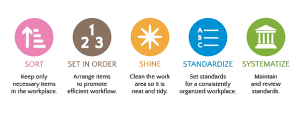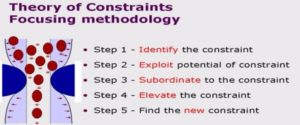
Step 1: Identify Comparison Opportunities
Sales Forecasts
Unless a manufacturer has implemented Vendor Managed Inventory, or has assumed the technology to support VMI, this can be seen to be a complex step. However, in general it should not be. From the manufacturers perspective a VMI-type network structure needs to be represented in their internal planning systems in order to store locally sales forecasting data. If no such system is available to them, all the work necessary to support this step will be managed via the CPFR solution acquired. In VMI a customer node is modeled in the planning systems to explain shipments from it (POS, consumer demand, store level pulls) and shipments to it (manufacturer shipments to the retail DC/store). This information is combined with some amount if Inventory Planning where order minimums, order up to levels and shelf or storage constraints are utilized in order to derive an order forecast.
In general, VMI and other continuous replenishment models are not widely adopted outside the Fortune 500 as EDI was a costly layer required to make VMI happen effectively. With CPFR however there is not such overhead so more companies can participate. However, the need to vain visibility to the sales forecast is critical. In general it is likely that the retailer will provide this data along with promotional details and facilitate the sharing of the information to the manufacturer via the CPFR solution. The manufacturer will take the resultant “firm” sales forecast (based on the agreed rules in step 2 of CPFR) and integrate those numbers into their planning process in order to derive an order forecast. As explained in the original paper, many times a retailer will be enabled to do this also. Partners will discuss the merit of each example and agree on an action plan.
Order Forecasts
Order forecasts are what a manufacturer would naturally call shipments. It’s what the manufacturers sales forecasting processes would have generated. In many cases up to this point the focus for that manufacturer would have been on internal one-number planning. The Sales and Marketing group would “own” the sales number; the financial group might “own” the budget, and the plant would generally “own” their own view of the world. Much effort has been spent on trying to determine the best practice model to rationalize all these disparate forecasts within the organization. CPFR says to the manufacturer: “ask the customer – they have a better idea of what’s going on, out in the real world”. The result of the traditional internal “one-number” planning process is a shipment forecast that is focused on the location from which the manufacturer will ship the product to the customer.
CPFR also extends what the manufacturer is going to see. Prior to Vendor Managed Inventory, the manufacturer would not have had any visibility into the channel activity that in truth often dictates what the manufacturers will in fact “see” in terms of customer orders. The order forecast is in fact a secondary priority in CPFR – after the sales forecasts. If buyer and seller (being more generic) can agree and buy-in to the sales forecasts (the retailers, or sellers, expectation of consumer demand) then the so-called translation to order forecasts should be a simpler calculation than it is today.
If a manufacturer has a forecasting process that generates a one-number plan for them, this is what should be offered as input to the order forecast part of CPFR. However, there is a data mapping that may be needed if the manufacturer’s data is generated at the “ship from” location and the retailers buying plan is generated at the “receive into” location. CPFR recognizes both locations and in fact long-term CPFR relationships will flourish if both locations are modeled. However, the real focus and benefit are derived when both buyer and seller operate to a one-number plan. Which locations that need to be modeled will depend on the network structure and complexities of each individual value chain. If dynamic sourcing for example is applicable, it is likely that manufacturing shipping locations will need to be modeled. Again, the CPFR solution is the environment in which the “2” is managed – the internal systems of the buyer and seller focus on the “B” and CPFR is the “2” in B2B.
The manufacturer also will discuss one other point with its customers. Many internal systems in place today focus on shipping dates. An MRP, ERP or MRP II “due date” is often the shipping date from the suppliers perspective. From an internal view looking out perspective, this is very natural and sufficient. From an outside looking in perspective (which is CPFR) this is part of the story. Both buyer and seller need to be aware of receiving date. More precisely it is the receiving date (at the retailer) that is used (made visible) to both parties in order to more effectively determine supply.
If the manufacturer (and the retailer, for that matter) has not yet achieved a process behind their firewall to synchronize and generate a one-number plan, then CPFR will meet with limited success and will be implemented with stress fractured built in that time (and forecast error) will push.
The most typical source of information for the order forecast is that the manufacturer provides the order forecast and via CPFR compares it to the suggested purchase order plan from the buyer/retailer. Or the CPFR solution compares sales forecasts to inventory and order forecasts and identifies exception conditions such as late delivery etc.
Step 2: Align Data Sources
Most manufacturers focus much of their previous forecasting efforts on item demand at a DC or plant level. Many have adopted a “pyramid” approach to one-number planning whereby all internal departments synchronize the planning process so that all operate on one agreed to number. Retailers, as explained in the original paper, operate at different levels, typically store level.
Another disparity is the time buckets and calendars that are observed. All companies have numerous time-related barriers or constraints that are used to manage information. CPFR is all about the “2” in B2B and consequently transcends company boundaries. Therefore these calendar constraints need to be reconciled – at a minimum to make data sharing and alignment possible. An example may help explain this:
Typical Manufacturers Calendar Model:
- 445 Financial Calendar
- Quarter end on 4th Friday (with exceptions)
- DC cannot ship on Tuesday’s after 4pm (union restrictions)
- DC cannot receive Saturday’s or Sunday, but can ship Saturdays
- Manufacturing cycles (line to DC) occur three times a day for some product lines, and range to once every 3 days for others
- Promotion cycles offered to customer have a 13 week cycle
- Systems shut down and batch maintenance takes place Wednesday evening and weekends, reducing on line availability
The retailer also has his or her own calendar and it does not match the manufacturer. Every company has such issues. CPFR mandates data aligning and we are just scratching the surface of what this means in terms of calendar alignment. In fact, alignment will not happen – it will in time be more of a rationalization between trading partners.
Step 3: Organize Data Views
One area that supports the multiple and alternative hierarchies is that of differing item codes. Larger companies can and do use UPC’s and/or EAN’s but in general these are still today being implemented by many companies. As products are sources from overseas, this issue grows in significance. In CPFR we need a solution that not only supports alternative views of the data but a simple way to translate “your item code into my item code”. This means that again, since CPFR is focused on the “2” in B2B, it cares about the link between the two companies. If both companies have agreed and implemented UPC’s and have common item code and description data, this is not an issue. Otherwise, this work will be part of the data mapping step described before – and then it will be used here in building personal views of the CPFR data.
Conclusion
Hopefully this short addendum provides some new incite into how CPFR can be implemented from the manufacturers perspective. Taken together, the two documents describe an exciting and dynamic business practice that is redefining how buyers and sellers (retailers and manufacturers) are doing business. Over the next couple of years, these guidelines are bound to change as more and more companies add to the growing body of knowledge.







